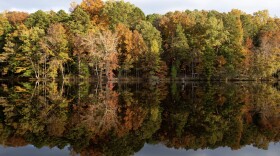The Nantahala-Pisgah Forest Plan is expected to be released at the end of the month. One piece of the puzzle is greater cooperation between the U.S. Forest Service and the Eastern Band of Cherokee.
When Ruby, the Capitol Christmas Tree harvested from the Pisgah National Forest, was on its tour across the state, it made a stop on the Qualla Boundary where the Forest Service and the Eastern Band of Cherokee celebrated a new chapter in their relationship.
“That was kind of the culmination of many months of work,” Secretary of Agriculture and Natural Resources for the Eastern Band of Cherokee Indians Joseph Owle said.
Last fall, the Eastern Band of Cherokee entered into two agreements with the Forest Service. These agreements can be proposed by any tribe under the Tribal Forest Protection Act, a federal law passed in 2004 to encourage cooperation between the Forest Service and Native communities.
“They look at the management of these areas in a co-stewardship fashion. So including the tribe in these decisions and asking for input and then sharing in the execution of some of the projects,” Owle said.
These agreements enhance the ability of the two groups to work together on projects, North Carolina National Forest Supervisor James Melonas said.
“The Tribal Forest Protection Act allows for the Forest Service to enter into an agreement with a tribe to work on projects that are of mutual interest, especially as it relates to things like reducing fire risk, and watershed resiliency and other potential impacts to tribal resources, that we can work on together to restore,” he said.
Melonas, who has served as Forest Supervisor since 2020, has experience working in collaboration with Indigenous tribes. Melonas previously served in the Santa Fe National Forest where he worked with local tribes in Northern New Mexico.

“We had many tribes and pueblos that we consulted with on the Santa Fe. And so that connection with our tribal partners was really important for me and something that was really one of the things I loved the most about being on the Santa Fe National Forest. And so [I’m] really excited to be able to advance that work here in North Carolina,” Melonas said.
This is the first time a group has signed an agreement under the Tribal Forest Protection Act in the Southern Region of the Forest Service.
U.S. Forest Service Southern Region Regional Forester Ken Arney told the Cherokee One Feather newspaper the law followed devastating wildfires that crossed from federal land onto tribal land the prior summer.
The process has already started with the Nantahala Pisgah Forest Plan. The final version of the plan is expected to be out at the end of month. A released draft version prioritizes indigenous knowledge and management techniques, Melonas said.
“One of the hallmarks of the NPFP plan that we've been working on has been engaging with our tribal partners, and those that have ancestral connection to this land. in our work engaging and partnering with the tribes that have a connection here to Western North Carolina we recognize, the need for us to continue to improve and expand that relationship to honor the connection to this lands,” Melonas said.

The Tribe and the Forest Service also have other priorities in common. Increasing the numbers for traditional plants such as ginseng, white oak, sochan and ramps is a big shared goal. Owle said they are working together on a plan to protect and increase white oaks.
“White oak stand management for artists and resources - and historically white oak area, the management of west North Carolina and ancestral landscape - it was burned very frequently by the Cherokee and our ancestors. And so that's disrupted the white oak population, the stands and the abundance and availability to our community members who are artisans,” Owle said.
They hope this first project will increase the availability of white oak for traditional Cherokee artists.
“I think we just want to figure out like, okay, let's get one project done, how do we get that done? Where can we smooth out the wrinkles? And then what's the next project?" Owle said.
The two groups agree on some priorities for projects down the line such as sustainable harvesting practices for culturally significant plants like ramps, ginseng and sochan; issues with invasive species, watershed resiliency and more, according to Melonas.
“The new plan, it creates a framework for us in moving forward. We recognize the importance of traditional ecological knowledge, and other ways in which we are consulting and, and partnering with tribes moving forward,” he said.







